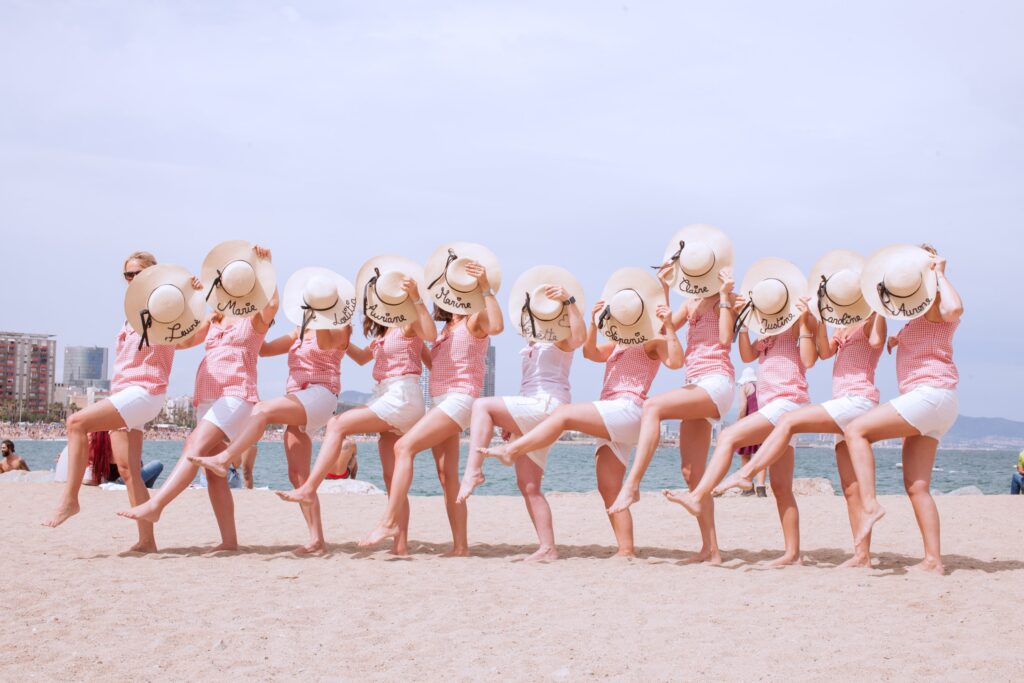There is a huge misconception in the salsa community about how to be a better follower.
Some dancers think that great following is the result of great leading. They think leaders are the cause, and followers are the effect.
Erase that from your mind.
The leader takes responsiblity for the dance. But you share that responsibility.

1. Accept Responsibility for Your Dance
One of the most amusing things I know is when women tell me that they can follow well only if they have a good leader.
Well…no. Your dance-level is fixed. You don’t suddenly get better just because you dance with a good leader.
You might feel better. Maybe it’s easier to follow because you get better signals.
But you don’t become a better follower the moment you dance with a good leader. (If you dance with good leader A LOT, then you become a better follower. But even then it’s not guaranteed.)
Followers who believe they follow well only when “the leader is good” tend to be unskilled. They believe good leading is rough leading. It’s the only leading they respond to because it’s the only leading they feel.
Don’t be so sure that it is the leader’s fault when your dances are always uncoordinated. As always in life: when you have the same struggle with a lot of people, it’s likely that you are the cause.
Time For a Shift in Perspective
If you believe that good following stems from good leading, you need a mindset-shift. As a follower, you are not at the mercy of your leader. In other words, good following is probably not what you think it is.
But there are things that you can do to become a better follower immediately. This article will help you achieve that.
But before we move on, repeat after me: “I am responsible for the quality of the dance.”
2. Relax Into The Frame
Nobody ever talks about this, but it’s important: You need to fully relax into the leaders frame.
The frame is his dancing-position, his open arms. It’s called frame because it’s supposed to provide guidance and stability to you as a follower. The frame’s job is to be reliable.
Relaxing into his frame is your job during the dance. Most men won’t even notice the difference. But some do. I certainly do.
It’s understandable that you have a hard time doing that with some leader. If they have a weird energy, are a little bit creepy, or lead roughly, it might actually be a good idea not to.
Nevertheless, a perfect dance (physically and emotionally), requires you to soften up and relax into his lead.
This “mental stuff” is especially important for you as a follower.
In my experience, men tend to be quite happy to just go through the motions when they dance. Doing the move is enough.
But as a follower, you probably need a little more than that. A good dance will have to provide psychological and emotional stimulation.
If you want to experience the emotionality of dancing, it’s mostly up to you. Most guys won’t get you there.
The result of “relaxing in to the frame” is often intimacy.
It sounds a bit scary if we put it like that, doesn’t it? It’s totally natural that you do not want to have that with every dancer.
But the best dances have strong intimacy (and a bunch of other stuff, about which we can talk another time).

What is “relaxing into the frame” exactly?
It feels something like this: You’re taking a deep breath, opening your heart a little bit, letting down the guard, make yourself vulnerable, and putting your trust in your leader.
It’s a bit intimidating. It feels similar to when you meet a new guy after going through a painful breakup. You know, that sense of “I’m not sure if I can show myself to another person again”.
Well, if you want to have magical dances, that’s what’s required of you. Generally speaking, being able to be open (or closed) on demand, it quite a handy skill to have.
A perfect dance (physically and emotionally), requires you to soften up and relax into his lead.
If you do relax into the frame, a sensitive leader will notice. They will feel that dancing with you is shallow. Your good technique won’t really make a difference here. To the leader, your “resistance” is unpleasant because it’s not authentic. You’re not really true to your role as a follower.
Relaxing into the frame requires practice, but it’s highly rewarding. Also, how much you relax should always depend on the guy you dance with. Some invite trust, others don’t. You have to follow your intuition.
If you think this all sounds very confusing (or exciting!) I recommend that you read some of David Deida’s books.
You may also benefit from taking private classes with an experienced leader that you feel safe with. I teach my students this principle. Most of them get it quickly, and some of them are deeply moved by the experience.
When you really get this idea, it’s like something deep inside you shifts into a more authentic mode of dancing.
3. Always Keep Stepping
Enough psychology. Let’s focus on some technical stuff.
As a follower, you have your rhythm: starting with the right foot, you step on 1-2-3, 5-6-7.
- As a rule, you should never break that rhythm. Not even your leader sucks.
- If he pulls you in the wrong direction, don’t let that mess with your step.
- If he is on the wrong beat, fine. Match his beat, but keep the stepping rhythmically .
Whatever happens, you keep stepping on 1-2-3, 5-6-7 (unless he’s leading you on-2, of course).

If he catches you on the wrong foot, that’s his mistake. The only way he will notice is if you maintain your (correct) stepping. If you change your own rhythm to match the leader, he will continue to think that he is on beat.
No! If he messes up, let him feel it.
Not stepping consistently is a problem. It’s also the number one thing I have to teach followers in private lessons. It’s so basic, yet very few women are able to do it.
Not stepping well won’t ruin your salsa. You might even dance for years without even noticing it.
But once you “get it”, everything will feel so much smoother and more relaxed. Re-learning is a lot more difficult than learning. So make sure you correct this as early as possible.
Bottom Line: Keep stepping, no matter what. On your toes, knees bent, bum out, upper body straight.
If you can do that, you will dance better than 90 percent of all female dancers.
4. Be Light
The best female dancers I know are like clouds. They don’t seem to weigh anything. A minimal signal is enough to get them moving into different directions. Just a little push sends them off in one direction. Just a tap on the shoulder makes them stop.
Being light really has two meanings.
- to be weightless (the opposite of heavy)
- to illuminate (the opposite of dark)
A great follower needs to embody both of these meanings.

1. Being Weightless
The first meaning, being light in the sense of being weightless, that is not-heavy, is easier to explain.
When you dance with another person, you are two bodies in space. It is the leader’s role to guide your body, to make you go from one point in space to the other.
But there is a terrible misunderstanding among beginner dancers. They think that leading actually means “dragging” the follower. They think that following means “being dragged”. Nothing could be further from the truth.
Leading is a signal. It is only a suggestion.
The movement by need to be completed by you! The leader tells you where to go, and then you go there.
It’s very rare that the leader will actually physically push or move you places. Being light means to understand that the leader will provide nothing but guidance.
When I dance with you, I “push” and “pull” you around. But I never actually push or pull. Once your body registers the signal, you should move by yourself.
The best female dancers I know are like clouds. They don’t seem to weigh anything. A minimal signal is enough to get them moving into different directions. Just a little push sends them off in one direction. Just a tap on the shoulder makes them stop.
As a leader, I never want have to grab, hold, drag, or push you hard. But this isn’t really up to me. It’s you, the follower, who is responsible.
If you don’t do you job, I have to do my job more roughly. And it’s not fun.
How to Feel Light
- To do that, you need a lot of dance practice.
- But more importantly, you need sensitivity. You need to pay attention all the time.
- The most important thing you can do to “feel light” for leader is to keep stepping (on your toes). As long you are stepping, your body is easy to move. But when you stop stepping or are on the wrong foot, your leader feels like he is rolling a rock up a mountain.
- Being light starts in your feet, but it characterises your whole body. When the leader gives you a signal to turn, you turn by yourself. All it should take for you to spin is a light is a slight push of your hand.
- When you spin, you are turning around your own center of gravity. Only in complicated turns that require you to spin several times should you feel the need to find stability in your leader’s body. Most of the time, you should be completely stable by yourself.
- (Hint: Whenever you feel like you’re losing your balance, you probably lean on the leader too much and therefore you will be the opposite of “light”).
As a general rule, remember never to use your leader to stabilise your own body unless you’re doing a difficult turn.
Generally, you need to stay completely upright in space, your weight only over your own feet, never leaning on the leader or using his arms or shoulders to keep your balance.
Only if you are self-reliant in your movement, will you feel light to your leader. Only if you don’t need him for stability, will you be really fun to dance with.
P.S. NO PANIC! Being light has nothing to do with your actual weight or height. It’s all about technique, sensitivity, and the right amount of tension in your body.
2. Illuminating the Dance-Floor
If you don’t provide the energy for the dance, there is no energy.
Being light also means to be the opposite of dark.
The leader’s role, once again, is to lead and to provide a frame for you. But your role as a follower is to shine.
Obviously both dancers want to interact and have fun together. But if you, as a follower, do not shine, the couple won’t shine either. (If you shine and he is focused on executing the movement, on the other hand, you will still shine as a couple!)
The dance, even though it is also a relationship, is primarily about you, about the feminine, about energy.
If you don’t provide the energy for the dance, there is no energy.
Then it’s just a self-absorbed guy showing off his moves (and you). Or perhaps the guy has access to his own feminine nature. In that case, he can do your job for you. But then there is also not good reason he should dance with you again, right?
Generally speaking, a dance becomes better when you are light. One aspect of being light is your ability to put trust into your leader. Another aspect is your ability to self-express, to be you.

Many moves in Cuban salsa are about showing off the follower, about presenting her. If the leader does one of these moves and you have as much energy as a wet bag of flour, the move won’t look like it’s supposed to.
In case you haven’t noticed: dancing is kind of flirty. Even if you’re not actually flirting, you still are in way. One-sided flirting is weird. But that’s exactly what’s happening if you cannot express yourself as light.
In a good dance, you will both ramp up the energy together. The guy will get really excited and do his crazy moves (partially to impress you). You will be (partially) impressed (or amused), which provides energy to the couple. But if you‘re not engaged, the entire dance will suck.
That why you need to be light, both weightless and illuminating, both like a cloud and like the sun.
4. Understand Male Psychology
Note: If you think you have men figured out, you can skip this part. This is an introduction to the secret emotional world of dancing men. It’s meant to help you understand your leader.
For the most part, you will be led by men.
Here’s something you need to know about men. They are terrified of two things:
- being rejected by the feminine
- being incompetent.

If this the first time you hear about this, you might want to pay close attention. It might improve your relationship to your partner–even outside the dance floor.
- Why is it that your boyfriend gets annoyed when you comment on his driving?
- How come he always shuts down if you point out his mistake?
The reason is simple: you are implying that he is incompetent. You might not mean it, but that’s what it feels like to him. (This book is old-school, but interesting nevertheless.)
The mere fact that you think he cannot do something by himself (and perhaps he actually can’t), makes him feel like he is failing. Men hate failing, generally speaking.
If you want to make a guy happy, make him feel like he knows what he is doing. Even if you are subtly guiding his actions so that he actually does the right thing.
Why are most men scared of asking women out on a date?
Because the idea of being rejected by a woman is an emotional nightmare to them.
If you reject him, it feels as if he is being rejected by all women. He is robbed of the possibility of ever having offspring (psychologically speaking).
This is the baggage he brings to the dance floor.
Many Dancing Men Are Insecure
Many men who go to dance classes do so in the hope of being more social and maybe even meeting a girlfriend. From the sample of all men (who tend to be insecure around women), your leader is from a particularly insecure sub-group. If you in a beginners-class, this insecurity is amplified even more.
So what’s all this psychology talk about? If you want to be a good follower, you need to know a little bit about leaders and how to make them feel at ease.
Dancing, for men, doesn’t come natural. Perhaps he never danced before. Let me assure you: he is doing his best to perform. And he probably cares a lot about what you think.
How to Be a Friendly Follower
- If you know each other, you can correct him, but in order to spare his ego, use suggestions instead of exclamations.
- If you do not know each other, do not tell him that he is doing it wrong. Instead, simply follow his lead.
- If his lead sucks, be patient. He’ll notice. He’s not stupid.
- If he’s doing something annoying (i.e. holding your hands too hard), try to tell him gently: “Maybe you can lose your grip a little? I have very sensitive hands.”
Note On Dealing With Creepy Dancers
After all that talk about nice guys, keep in mind that it’s okay if you don’t want to dance with a particular guy.
There are a bunch of creepy dancers out there, and it’s not unusual that my female student tell me that they feel somewhat harassed by them.
Practicing assertiveness as a woman is not the subject of this article. But there is no reason you cannot reject a dance. If he can’t handle it, it’s his problem.
5. Give Positive Feedback
This builds on the male psychology described above. If somebody is insecure, they appreciate compliments.
If you enjoy yourself, let him know. I know that sounds like relationship advice. That’s because it is: dance is relationship.
Since most men are so self-conscious in the beginning, it’ s very helpful if you boost their confidence when they deserve it.

Many people respond better if you tell them what was good rather than pointing out their flaws: “I like how you did not dance-off beat two minutes into the song!”
Due to the nature of your roles in dancing, the leaders usually won’t know if they did well. That’s why you need to tell him. If you don’t tell him, he will never know.
As a follower, you know when do well. You can tell when you managed to go complete the moves that your leader initiated.
But leaders do not receive such automatic feedback. Somebody needs to tell them if they do well, so they can do more of it. If nobody tells them how they are doing, they will simply have to guess.
Positive feedback does’t just include words. It could also be a smile. And the best feedback, of course, is to ask him for another dance.
6. Never Lead the Leader
If you do the moves for him, you rob him of the chance to truly learn to lead. If you help him too much, he’ll never learn.
The previous paragraphs we lay the groundwork for this section. Since your role in salsa is to follow, you do not want to take charge of the dance. Responsibility is good, but ultimately, it’s still the leader who decides what to do. (If you don’t like that, become a leader yourself.)
Above we mostly focused on not leading him psychologically, meaning that you allow him to feel competent.
But you shouldn’t lead him physically either.

The basic role distribution in salsa is this: the leader leads, the follower follows. The leader knows what move comes next, the follower doesn’t.
Dance class isn’t the real world. It’s training. In class, you happen to know what comes next. This does not mean that you should lead the move. It might feel like you’re helping him at the time. Well, you’re not.
Let Him Fail
If you do the moves for him, you rob him of the chance to truly learn to lead. If you help him too much, he’ll never learn.
Let him fail. Not letting him fail, is like being a germaphobe that’s raising a child. Since everything in your home is hermetically sealed, the child gets no exposure to bacteria. And that’s great, but only as long as it stays inside.
You can help your leader learn the moves in class, especially if you understand them better than he does. You can tell him where to put his arms, feet, and where to pull you. Do that until he gets the idea, but then stop.
Don’t allow him to live in the illusion that he is successful, when he is actually not.
Avoid This Mistake
If you continue to take the lead, you also turn yourself into a bad follower. You won’t be very nice to dance with. What feels like help to a beginner leader feels like resistance to an advanced leader. Good leaders don’t need your help and they don’t want it either.
If you get into the habit of “trying to help,” stop immediately. The longer you continue with this, the more difficult it will be to relax into the lead later on.
7. How to Be Attractive to Dance With
Be Positive
Many leaders have trouble keeping the rhythm in the beginning. Don’t just bluntly tell him that he’s off-beat. For many guys, it’s humiliating. (Remember competence?)
More often than not, the leader knows that he is off-beat. You can tell by his insecurity.
If you want men to dance with you again, don’t just go around complaining about what they do.
However, you can help correct it with something like simple glance. Lift an eyebrow, smile; charm him into noticing his own mistake. That’s your gift to him. And he will be grateful for it.
Move While You Wait
Many followers complain that the best leaders only dance with the young, pretty dancers. Well, it’s true.
And why wouldn’t they? If you could choose from different options, you would also pick the most attractive!
The reason many leader will pick the young, pretty dancers is that they are
- young and pretty
- often more fun to dance with
- often better followers (more light, more relaxation)
That being said, I know also many leaders (myself included) who will dance with anybody if (and only if) they can expect the dance to be fun.
The question is therefore how you can communicate that you will be fun to dance with.
You can start out by being friendly and in a good mood. You should wait next to the dance floor, moving by yourself, smiling.
At most salsa parties, the male-female ratio is in strongly in favour of women. That’s why you need to make sure to look like you’re a good dancer partner.
Nobody in their right mind will ask a stiff-looking, grumpy person to dance.
8. First things first: Competence
Almost everything we talked about in this article requires attention. You can only pay attention if you have free mental space.

Your brain is like a hard disk.
If you’re running a bunch software at once, additional programmes will barely open (especially if you’re on Windows).
As long as you’re still busy keeping the beat and avoiding to bump into other dancers, it will difficult to focus on the nuances of good leading and following.
How to Get Good at Salsa Fast
Once you stick to the rhythm effortlessly, never end up on the wrong foot, understand the music, and know how to deal with a large variety of moves, it will be a lot easier to focus on your partner.
Only if you don’t consciously have to think about your own body, can you fully focus on your partner’s energy, movement, and needs.
Competence is the result of
- taking a lot of classes with a good teacher (which isn’t always the same as a good dancer),
- watching videos of dancers you admire,
- going out social dancing as much as possible,
- and perhaps even taking private lessons.
I have personally taken more than 300 private lessons in salsa when I started out, and I recommend that you take private lessons to get personal feedback.
Anytime you dance, you become more competent.
But if your technique is off, you might turn your mistakes into a pattern. Do this long enough and you’ll be stuck with your mistakes forever.
It’s the truth; I see it all the time. People who dance in a bubble (like a small town or a specific school which teaches weird things), are stuck with their early misinformation forever.
Becoming a great follower is a process that requires time and attention. Be patient with yourself. But remember that it’s in your power to make it happen.

